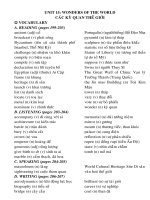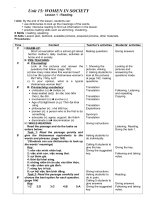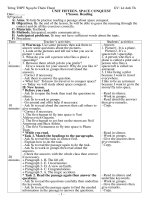- Trang chủ >>
- Y - Dược >>
- Y học công cộng
Unit 15 Space conquest
Bạn đang xem bản rút gọn của tài liệu. Xem và tải ngay bản đầy đủ của tài liệu tại đây (1.08 MB, 29 trang )
<span class='text_page_counter'>(1)</span>
<span class='text_page_counter'>(2)</span> Unit: 15 Space Conquest. A. READING.
<span class='text_page_counter'>(3)</span> Playing game. Matching Match these words with suitable pictures.
<span class='text_page_counter'>(4)</span>
<span class='text_page_counter'>(5)</span> Cosmonaut The first man to step foot on the moon. Temperature. Rocket. Spacecraf The first human to fly into space. Weightlessness The first Vietnamese to fly into space. The moon’s surface.
<span class='text_page_counter'>(6)</span> The first man to step foot on the moon. Weightlessness. Temperature. Rocket. The first Vietnamese to fly into space. The moon’s surface. Cosmonaut. Spacecraf. The first human to fly into space.
<span class='text_page_counter'>(7)</span> Work with a partner. Ask and answer the following questions. 1. Who is the first human to fly into space? Yuri Alekseyevich Gagarin (9 March 1934 – 27 March 1968) was the first human to journey into outer space, when his Vostok spacecraft completed an orbit of the Earth on 12 April 1961..
<span class='text_page_counter'>(8)</span> 2. Can you name the first humans to set foot on the moon? Neil Alden Armstrong (August 5, 1930 – August 25, 2012) was an American astronaut and the first person to walk on the moon. 3. Who is the first Vietnamese to fly into space? The first Vietnamese to fly into space was Pham Tuan.
<span class='text_page_counter'>(9)</span> VOCABULARY • Conquest /ˈkɒŋkwest/ (n):sự xâm chiếm, sự chinh phục • Lif into space /lɪft ˈɪntə speɪs/ :bay vào vũ trụ • Approximately /əˈprɒksɪmətli/ (adv):khoảng chừng • Orbit /ˈɔːbɪt/ (n):quỹ đạo (v):chuyển động theo quỹ đạo • Cosmonaut /ˈkɒzmənɔːt/ (n):nhà du hành vũ trụ • Enormous /ɪˈnɔːməs/ (a):to lớn, khổng lồ.
<span class='text_page_counter'>(10)</span> VOCABULARY • Uncertainty /ʌnˈsɜːtnti/ (n):sự không chắc chắn, tình trạng không biết chắc • Precisely /prɪˈsaɪsli/ (adv):đúng, chính xác, một cách cẩn thận • To react to /riˈækt/ (v):tác động, gây ảnh hưởng trở lại, phản ứng lại • Extreme /ɪkˈstriːm/ (a):cách xa hết mức, rất xa • To deal with /diːl wɪð/ (v):giao du với, có quan hệ với, giao thiệp với.
<span class='text_page_counter'>(11)</span> VOCABULARY • Psychology /saɪˈkɒlədʒi/ (n):tâm lý, tâm lý học • Tension /ˈtenʃn/ (n):căng thẳng, tình trạng căng • Weightlessness /ˈweɪtləsnəs/ (n):tình trạng phi lực To weight (v):cân nặng, có ảnh hưởng lớn Weight (n):trọng lượng • Telegram /ˈtelɪɡræm/ (n):bức điện tính • Venture /ˈventʃə(r)/ (n):công việc kinh doanh (v):liều, mạo hiểm. thẳng trọng.
<span class='text_page_counter'>(12)</span> Read the text about Yuri Gagarin and then do the tasks that follow..
<span class='text_page_counter'>(13)</span> 1. At 9.07 a.m. Moscow time on 12th April, 1961, Yuri Gagarin lifted off into space aboard the Vostok 1. Approximately 12 minutes later, the first human being was in orbit around the Earth at a speed of more than 17,000 miles per hour. His flight lasted 108 minutes..
<span class='text_page_counter'>(14)</span> 2. The 27-year –old Soviet cosmonaut became the first person to eat and drink in weightlessness. From his window in space, Gagarin was able to view the earth in a way that no human beings had done before. The first words spoken from space were: “I see the Earth. It’s so beautiful!”.
<span class='text_page_counter'>(15)</span> 3. Before Gagarin’s historic flight, there were still enormous uncertainties. No one knew precisely what would happen to a human being in space. How would the body react to the extreme changes in temperature? How would the mind deal with the psychological tension? If there was a technical failure, Gagarin might never get back to the Earth..
<span class='text_page_counter'>(16)</span> 4. The success of Gagarin’s flight attracted worldwide attention and made him a hero. In a telegram to Moscow, U.S. President John F. Kennedy wrote, “The people of the United Stated share with the people of the Soviet Union their satisfaction for the safe flight of the astronaut in man’s first venture into space. We congratulate you and the Soviet scientists and engineers who made this feat possible….”.
<span class='text_page_counter'>(17)</span> 5. Gagarin could have made another space flight if a tragic accident had not occurred. He died in a plane crash on a routine training flight in March 1968. After his death, his hometown of Gzhatsk was renamed Gagarin, and the Cosmonaut Training Centre at Star City, Russia, was given the name of this national hero..
<span class='text_page_counter'>(18)</span> Task 1. Match the headings to the paragraphs Paragraph 1. A. The tragic accident. Paragraph 2. B. The lift-off. Paragraph 3. C. Congratulations. Paragraph 4. D. A view on Earth. Paragraph 5. E. Uncertainties.
<span class='text_page_counter'>(19)</span> Task 2. Read the passage again and answer the questions. 1. How old was Gagarin when he became the first human being in space? He was 27 when he became the first human being in space 2. How long was he in space? He was in space for 108 minutes..
<span class='text_page_counter'>(20)</span> 3. What questions were raised before Gagarin’s space flight? Before Gagarin’s space flight, there were lots of questions such as what would happen to a human being in space or how the body would react to the extreme changes in temperature or how the mind would deal with the psychological tension. 4. What was the speed of his spacecraf in orbit around the Earth? It was more than 17,000 miles per hour..
<span class='text_page_counter'>(21)</span> 5. Why couldn’t Gagarin make a new space flight? Because he died in a plane crash on a routine training flight in March 1968. 6. What was done afer Gagarin’s death to honour this national hero? After his death, his hometown of Gzhatsk was renamed Gagarin, and the Cosmonaut Training Centre at Star City, Russia, was given the name of this national hero..
<span class='text_page_counter'>(22)</span> Task 3. Complete the summary of the reading passage by putting the words/phrases in the box into the blanks. impossible named after. lasted. gravity. success. in space. cosmonaut. view.
<span class='text_page_counter'>(23)</span> On 12th April, 1961, Yuri Gagarin, a Russian (1)_______ became the first human being (2)_______. Although his flight (3)_____ only 108 minutes, its (4)________ made him a national hero. He also became the first person to eat and drink in zero (5)_______, and he was able to (6)________ the Earth in a way that no one had done before. Unfortunately, a plane crash in March 1968 made Gagarin’s desire of revisiting space (7)_______. After his death, his hometown and the Training Centre at Star City, Russia were (8)______him..
<span class='text_page_counter'>(24)</span> On 12th April, 1961, Yuri Gagarin, a Russian (1) cosmonaut became the first human being (2) in space. Although his flight (3) lasted only 108 minutes, its (4) success made him a national hero..
<span class='text_page_counter'>(25)</span> He also became the first person to eat and drink in zero (5) gravity, and he was able to (6) view the Earth in a way that no one had done before. Unfortunately, a plane crash in March 1968 made Gagarin’s desire of revisiting space (7) impossible. After his death, his hometown and the Training Centre at Star City, Russia were (8) named after him..
<span class='text_page_counter'>(26)</span> More exercise: Choose the word or phrase-a, b, c or d- that best complete the sentence or substitutes for the underlined word or phrase.. 1. Neil Amstrong was the first man to walk on the moon______20 July 1969. a. in b. at c. on d. of.
<span class='text_page_counter'>(27)</span> 2. She is never satisfied_____ what she’s got. a. to b. with c. for d. in 3. In 1961 Yuri Gagarin lifed ______ into space aboard the Vostok 1. a. off b. up c. on d. at 4. No one knew precisely what would happen to a human being in space. b. exactly b. clearly c. carefully d. vividly.
<span class='text_page_counter'>(28)</span> 5. Neil Armstrong, an American ______ , was the first man to step on the moon’s surface. a. scientist b. cosmonaut c. astronaut d. astronomer 6. The 27-year-old soviet cosmonaut became the first person to eat and drink in____. a. weight b. weighting c. weightless d. weightlessness.
<span class='text_page_counter'>(29)</span> 7. The astronauts were able to send the information back to the earth. a. spaceships b. space stations c. spacemen d. space shots.
<span class='text_page_counter'>(30)</span>









